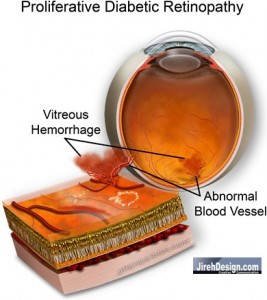08 Jan Blood in the Eye: You Make the Call
Last week another long time patient of mine (as most are with diabetic retinopathy and macular degeneration) returned with complaints of the sudden onset of floaters in the left eye. The floaters had been present for about one month, they hadn’t cleared and he made an appointment.
I’ve added this illustration that resembles what I saw after dilating his pupils. What do you see?
My patient has had diabetes mellitus for about 18 years. He is 64 years old. Several years ago, he had a similar problem in the other eye. He developed a vitreous hemorrhage from proliferative diabetic retinopathy. In the illustration above, note the abnormal blood vessels, so-called “neovascularization,” that has formed on the surface of the retina.
Neovascularization develops when the oxygen supply to the retina is poor, causing retinal ischemia. The ischemic retina then produces VEGF (vascular endothelial growth factor) in response to this lack of oxygen – sounding familiar? The VEGF causes neovascularization to proliferate.
Neovascular blood vessels are also very fragile. They can break open and bleed at any time and without apparent cause. The blood physically blocks light. A little bit of blood may cause “floaters,” while substantial bleeding seems to fill the eye, severely affecting vision.
What is next? My first job is to make sure that nothing else is causing the vitreous hemorrhage. A tear in the retina can cause a similar picture. If there is no hemorrhage, then I am more confident that the hemorrhage might be due to diabetic retinopathy. Our choices at this point are; observation (aka do nothing) or perform a vitrectomy eye surgery. Ultimately, any patient with proliferative diabetic retinopathy needs pan-retinal photocoagulation (laser treatment). At the present state, blood physically blocks light, therefore, laser treatment is not possible. We can either wait for the blood to absorb, and then perform laser surgery, or go ahead an perform a vitrectomy, remove the blood and perform laser all at once. We operated.
What Does This Mean? In cases of vitreous hemorrhage due to diabetic retinopathy, the single most important therapeutic option is to perform PRP (pan-retinal photocoagulation). This will indirectly stop the VEGF from being produced and the neovascular tissue will regress; that is, shrink up and go away. Vision is stable, chance of blindness is halted.
VEGF is also implicated macular degeneration. It is the same VEGF. Avastin and other anti-VEGF drugs (Lucentis/Macugen) are also used to control proliferative diabetic retinopathy…at times. I use it when the laser doesn’t seem to be working, but I expect more and more docs will use it the future.
“Randy”
Randall V. Wong, M.D.
Ophthalmologist, Retina Specialist
Fairfax, Virginia


![Reblog this post [with Zemanta]](http://img.zemanta.com/reblog_e.png?x-id=3b2d426a-f6be-4f32-80ff-592d6f9aca5a)
No Comments